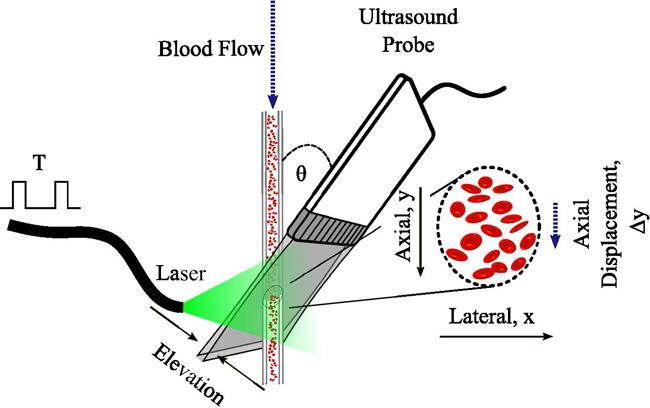

Experimental setup for blood flow velocity measurements using AR-PAF. A polyethylene tube of 580 μm inner diameter serves as a vessel phantom. It is illuminated with successive laser pulses to generate PA signals. Blood flow through the tube is controlled using a syringe pump. The PA signals are detected with a 64 element ultrasound transducer array (center frequency=15??MHz). The array is positioned such that a cross section of the tube is imaged, and the orientation at an angle θ to the tube enables motion of the cells to be observed as a displacement in the axial direction of the transducer. The phantom and the transducer were held in place using custom-made holders.
Credit: Thore M. Bücking; Pim J. van den Berg; Stavroula Balabani; Wiendelt Steenbergen; Paul C. Beard; Joanna Brunker
In an article published in SPIE's Journal of Biomedical Optics, researchers announce new advances in measuring blood flow velocity in deep tissue. Blood flow speed is a critical element in assessing tissue functionality as well as diagnosing diseases, and photoacoustic flowmetry (PAF) is already acknowledged as a promising technique for deep tissue measurement of blood flow velocity.
The new work demonstrates successful use of a handheld ultrasound probe common in clinical settings, paving the way to explore the feasibility of measuring flow in a physiologically realistic situation.
The article, “Processing methods for photoacousitc Doppler flowmetry with a clinical ultrasound scanner,” by Thore M. Bücking, Stavroula Balabani, Paul C. Beard, and Joanna Brunker of University College London, and Pim Jasper van den Berg and Wiendelt Steenbergen of University of Twente, outlines key steps in their processing methods – including image filtering, motion detection, and masking – that bring photoacoustic flowmetry an important step closer to clinical applicability, according to Journal of Biomedical Optics editor, Andreas Mandelis.
“The manuscript by Brunker and her colleagues has reported, I believe, one of the most important steps forward in photoacoustic flow measurements, by using a clinical ultrasound array, human whole blood, and wide-field optical illumination in AR-PAF settings,” says Mandelis. “This long-overdue work is extremely exciting for the photoacoustic imaging community, and can potentially bring photoacoustic flow imaging into clinical practice.”
###
Brian Pogue, professor of engineering at Thayer School of Engineering at Dartmouth, is the editor-in-chief of the Journal of Biomedical Optics. The journal is published in print and digitally by SPIE in the SPIE Digital Library, which contains more than 460,000 articles from SPIE journals, proceedings, and books, with approximately 18,000 new research papers added each year. The journal will become fully open access on 1 January 2019.
About SPIE
SPIE is the international society for optics and photonics, an educational not-for-profit organization founded in 1955 to advance light-based science, engineering, and technology. The Society serves nearly 264,000 constituents from approximately 166 countries, offering conferences and their published proceedings, continuing education, books, journals, and the SPIE Digital Library. In 2017, SPIE provided more than $4 million in support of education and outreach programs. http://www.
Contact:
Daneet Steffens
Public Relations Manager
+1-360-685-5478
daneets@spie.org
@SPIEtweets












